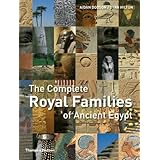
Average Reviews:

(More customer reviews)"The Complete Royal Families of Ancient Egypt" is probably not a book for everyone, even for those with a casual interest in the Pharaohs of Egypt. The latter might glean some of the basic history of the succession and of the basic events of the pharaohs, but almost 2/3 of the book is dedicated to the known individual members of these families and the physical record that supports both their identities and their relationships.
Most interesting for the general reader will be the proposed relationships between some of the dynasties. It would appear that in many transitions from one ruling family to the next, there was at least a tenuous link between them often by way of collateral members of the previous dynasty. These links, however, are made somewhat tenuous by the fact that similar names reoccur, not only through the generations but sometimes within a generation--often as the result of one person with the name dying and a newborn brother or sister being given the same name again. Proposed links are often made on the basis of other data identifying the individual, usually similar titles, or by more specific information taken from the tombs or other property of relatives or official subordinates. The roundabout way of creating biographies of these people is truly ingenious. It shows how thin on the ground actual historical evidence really is and how and on what Egyptian history is written. The importance of the tomb data from officials and collateral family is very clear.
I was surprised to find that a number of details in the histories of individual rulers had been changed based on new interpretation of old data. Ramses II had been believed to be a usurper of the throne and guilty of the murder of his presumed elder brother, but recent scrutiny of the monumental data for this supposed event has since exonerated him of the crime of fratricide. Apparently the "elder" son did not exist, the fragmented data on which his existance was based is actually about another person, apparently a minor military person.
A personal error of my own was also clarified. I have been in the tomb of Amenhirkopshef, whom I knew to be the eldest son of Ramses II by his Queen Nefertiry (possibly the son who died in one of the plagues in the Bible) but as it turns out that particular son was buried in a group tomb, KV5, built for the sons of Ramses II while that which I had seen (QV55) was of another younger man of the same name who was a son of Ramses III. (The tomb contains beautiful paintings, comparable to those of Nefertiry, from the Ramsid era).
It would also appear that there is more information about Nefertiti's possible origin; Ay having been suggested as her father and also as the brother of Queen Ty, which would certainly explain Nefertiti's considerable political presence at the Armarna court during her reign and Ay's unusual succession to the throne after the death of Tutankhamen. (One can't help but wonder what kind of major drama was taking place at the end of the 18th Dynasty.) Previously it had been suggested that she may herself been a Hittite princess, which would have made her daughter's request for a Hittite Prince as consort reasonable, ie. a cousin marriage. Having since seen the translation of the original letter, I would say it's arrogance suggests there was little sense of family.
The identity of Akhenaton's secondary wife, Kiya, as Tadukhipa, the daughter of the Mitannian king Tushratta, also seems plausible. I had read years ago that it was believed that Tadukhipa, while sent to be a bride for Amenhotep III, had become instead the wife of his successor, Amenhotep IV (Akhenaton). A previous marriage of a daughter of Shuttarna II the previous king of Mitanni, Gilukhipa, actually does seem to have taken place with Amenhotep III and is recorded by a marriage scarab. The likelihood of successive dynasts of the two kingdoms re-engineering their international contracts in this way is strong, and the name Kiya might easily be in keeping with either of the ladies. Given the power of Queen Ty and Nefertiti at their respective courts, it is hardly surprising that nothing much else was heard of either of the foreign princesses.
Interesting book, but probably more for those with a high rather than casual degree of interest in Egyptian history. For the latter I would suggest Chronicle of the Pharaohs: The Reign-By-Reign Record of the Rulers and Dynasties of Ancient Egypt by Peter A. Clayton. ("Product link" does not work for this listing or the author, but the book is listed under its title.)
Click Here to see more reviews about: The Complete Royal Families of Ancient Egypt (The Complete Series)

0 comments:
Post a Comment